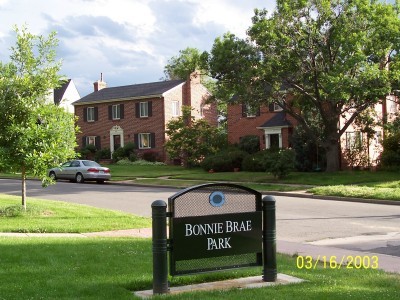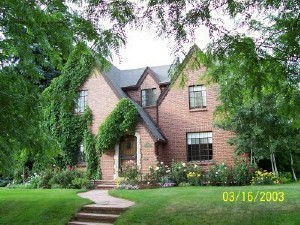Bonnie Brae Neighborhood
Our Information
- Contact List
- Our contact information...
- Newsletter Archive
- Previous Newsletters...
About Us
Bonnie Brae Neighborhood

About the Bonnie Brae Neighborhood
The History of Bonnie Brae
Winding streets surrounding and elliptical-shaped park make Bonnie Brae a serene residential enclave in the midst of the city.
Located east of University Avenue between Mississippi and Exposition Avenues, Steele Street and University Boulevard, Bonnie Brae was developed in the 1920's on land that had been granted to the Kansas Pacific Railroad in 1870. The railroad eventually sold the land to farmers, and later it became part of the town of South Denver, one of the many small communities annexed by Denver.
George W. Olinger, one of the city's most active businessmen in the 1920's, began accumulating property in the area for his land development company, the Associated Industries Company. Olinger had been impressed by a subdivision he saw in Kansas City that was named Bonnie Brae, meaning "pleasant hill" in Gaelic. Borrowing the name, he strived to recreate the aura of peaceful Scottish village in Denver. In 1923, the company hired the noted landscape architect Saco DoBoer to design the street system for the new neighborhood in a fashion similar to the Kansas City subdivision. In planning the neighborhood of Bonnie Brae, DeBoer departed from the grid system that characterized most of Denver's streets and focused on the land's topography and natural beauty. The first homes were constructed in 1923 and 1924.
To demonstrate pride in the neighborhood, Olinger erected stone pillars at the entrances on Tennessee and Kentucky streets which remain today. Subdivision fillings were completed in April 1925, the same year Olinger sold his share of the Associated Industries Company. Three years later, the company declared bankruptcy, and most of Bonnie Brae fell into the city's hands for tax debt. Further development in the area slowed as the depression gripped the country in the 1930's.
The delay in development of Bonnie Brae proved to be beneficial in the long run. The 1920's and 1930's were exciting eras in the field of architectural design. In Europe, architects and designers were experimenting with bold new styles that later became known as Art Moderne and the International Style. Traditional notions of symmetry and decorative ornament exemplified by Neoclassic and Victorian designs were rejected, while new materials and technological advances enabled innovations in architectural compositions. The International materials and technological advances enabled innovations in architectural compositions. The International Style, as expressed by architects of the Bauhaus School in Germany, focused primarily on building's function with the idea that "less is more." Art Moderne structures used classic elements in new ways, emphasizing horizontal lines and softening angles with curved corners.
By the end of the Depression, when Denver development resumed, many of the homes in Bonnie Brae were being constructed in these revolutionary styles.
The turning point in the neighborhood's development came in 1936 when Ellipse Park, the centerpiece of Saco DeBoer's plan, was constructed. Homes built up around the park. A decade later, when World War II ended, housing construction boomed and most of the homes east of the park were constructed in an era of post war prosperity.
As Bonnie Brae grew, businesses opened along the 700 block of University Boulevard. Carl and Sue Dire opened the Bonnie Brae Tavern in June 1934, seven months after the repeal of Prohibition, and it continues as a neighborhood gathering spot. The Bonnie Brae Tavern and other busineses form a thriving commercial area between Exposition and Ohio streets that still function as the "Main Street" of one of Denver's most charming neighborhoods.
Bonnie Brae Business District
In and age of chain stores and strip malls, Bonnie Brae's quaint commercial district is one of the neighborhood's most charming features. Within walking distance are favorite spots for pizza, spaghetti, fine dining, coffee, and home made ice cream. It's hard to believe the variety available with the short strip on University Avenue between Exposition and Ohio. It also has a branch library, a gas station, a liquor store with a great wine selection, two flower shops, two cleaners, gift shops and more.
The commercial strip actually pre-dates the neighborhood. By the late 1920's University Boulevard was already becoming a major north-south transportation artery, although Bonnie Brae was largely undeveloped. Two gas stations, Conoco and Shell, served the passing motorists in the early years, along with a drug store and other shops. The gas stations survived the Depression years, but the others did not.
In 1934, the owner of the Shell station took advantage of the end of Prohibition to open a tavern next to the service station. The gas station disappeared years ago, its place now taken by a bank, but many original Bonnie Brae busineses have remained.
As the population of residents increased in Bonnie Brae, the commercial district grew. In 1938, Dolly Madison Dairy opened a store, its second in the city. Bonnie Brae flowers opened in 1941, Bonnie Brae drug reopened, and other stores opened in the early 1940's including Volmer's Bakery and the Bellaire Restaurant (the Campus Lounge since 1961.) At one point, there were four gas stations and a dozen other businesses including three groceries.
By the 1960's, the street, an almost empty stretch in the 1930's, had become a boulevard lined with locust trees. When the city widened University Boulevard in the early 1960's the trees were cut town. Some of the current businesses date from this time, including the Saucy Noodle and the Campus Lounge. The past decade has seen new enterprises taking the place of old ones, Bonnie Brae Ice Cream replaced Dolly Madison Dairy. Pour La France, and then "Seven 30" restaurant replaced one of the gas stations, and the Dutch Flower Marked occupies another.
Through the years the neighborhood business district has adapted to change, and today is one of the city's prime commercial locations.
Links
Map of Bonnie Brea Neighborhood
About our association

Bonnie Brae Neighborhood Association
Bonnie Brae has had an organized neighborhood association for many years. We are a small area (around 700 homes)and we partner with an active Merchants Association, our City Council, and the City of Denver. Bonnie Brae has an annual picnic each year in late summer at Bonnie Brae Park. This is a great time to meet neighbors if you are new to the neighborhood or re-connect with those you have not seen in a while. The picnic is also the venue for our one all-neighbor meeting including elections for the Bonnie Brae Neighborhood Association Board. This board meets on a regular basis,puts out a quarterly newsletter both in hard copy and electronically, and coordinates the annual picnic. Additionally, the zoning committee reviews any pending zoning requests.
Our mission is to share information and provide a conduit with the city; assist in community development, and facilitate any efforts to improve quality of life in Bonnie Brae.
Board of Directors for Bonnie Brae Neighborhood Association
2007-08 President
Mary Broere
303.777.7374
mary@thirdbrew.com
2007-08 Vice President
Lynn Crist
lynncrist@comcast.net
Treasurer
Barb Drews
Secretary
Kathy Stollar
katstollar@aol.com
Newsletter Editor
Mike Slattery
Mslats64@aol.com
Past President
Dave Bell
Steering Committee
Renee Arrington
Dejan Damjanovic
Susan Diliberti
Nancy Eggert
Diane Heidel
Patty Lewis
Patricia Robertson
Bonnie Brae Newsletter
We encourage you to participate in supplying items of interest to the community for our publication. Please submit all materials, including any advertising requests to our Newsletter Editor, Mike Slattery at mslats64@aol.com.


